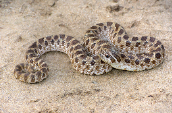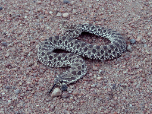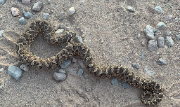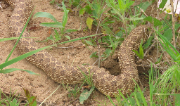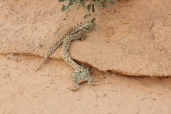Plains Hognose Snake (Heterodon nasicus)
Description: The western hognose snake is a relatively small, stout-bodied snake. Its color and pattern is highly variable between subspecies, although most specimens appear much like rattlesnakes to the untrained eye, which appears to be Batesian mimicry. Males are considerably smaller than females, with adults rarely exceeding a total length (including tail) of 15–20 inches. This snake gets its common name, "hognose", from the modified rostral (nose) scale that is formed in an upturned manner, providing a very "hog-like" look. Additionally, this adaptation makes these snakes adept burrowers.
Habitat: It frequents areas with sandy or gravelly soils, including prairies, river floodplains, scrub and grasslands, semi-deserts, and some semiagricultural areas. It has been found at elevations of up to 8,200 feet.
Range: The western hognose snake occurs from southern Canada throughout the United States to northern Mexico.
Diet: In the wild, the western hognose snake feeds predominately on amphibians, such as large and medium-sized tree frogs, as well as small or medium-sized toads and small lizards. There have been accounts of H. nasicus eating the occasional rodent in the wild as well. Not being a true constrictor, Heterodon bites and chews, driving the rear fangs into the prey as a way of introducing the saliva to help break down the toxins from toads. There have been many cases of hognose snakes in captivity that will not eat for about two to three-and-a-half months, from the months January to mid March. This is because hognose snakes' instinct is to brumate underground during the winter months.
Reproduction: Adult western hognose snakes have been observed in copulation as early as February and March. The species is oviparous, with females laying 4–23 elongate, thin-shelled eggs in June–August. The eggs take approximately 60 days to hatch. Each hatchling is 5 to 9 inches in total length, and reaches sexual maturity after approximately two years (this is predominantly based on size, not so much age).
Status: Listed as Least Concern in view of its wide distribution, presumed large population, and because it is unlikely to be declining fast enough to qualify for listing in a more threatened category.
»» Kingdom: Animalia - Animals
»» Phylum: Chordata - Chordates
»» Subphylum: Vertebrata - Vertebrates
»» Class: Reptilia - Reptiles
»» Order: Squamata - Scaled Reptiles
»» Suborder: Serpentes
»» Superfamily: Colubroidea
»» Family: Colubridae - Colubrids
»» Genus: Heterodon
»» Species: Heterodon nasicus - Plains Hognose Snake
This article uses material from the Wikipedia article "Western hognose snake", which is released under the Creative Commons Attribution-Share-Alike License 3.0. Content may have been omitted from the original, but no content has been changed or extended.
|




